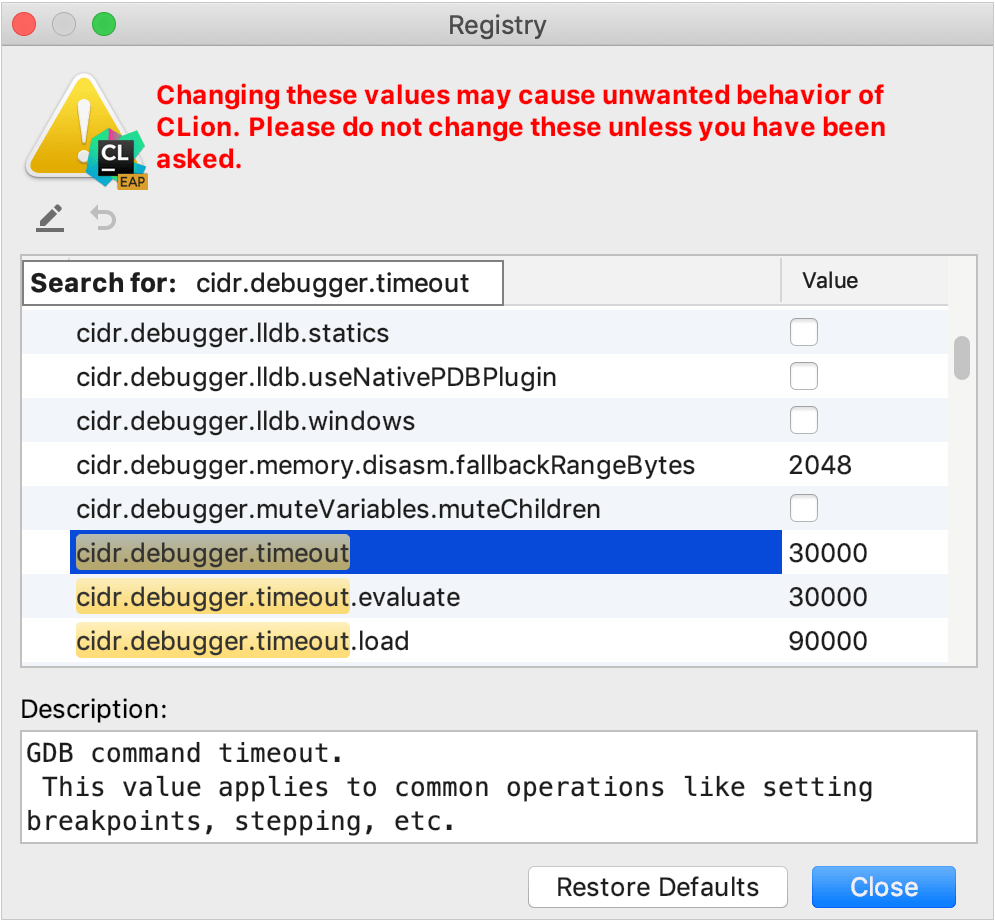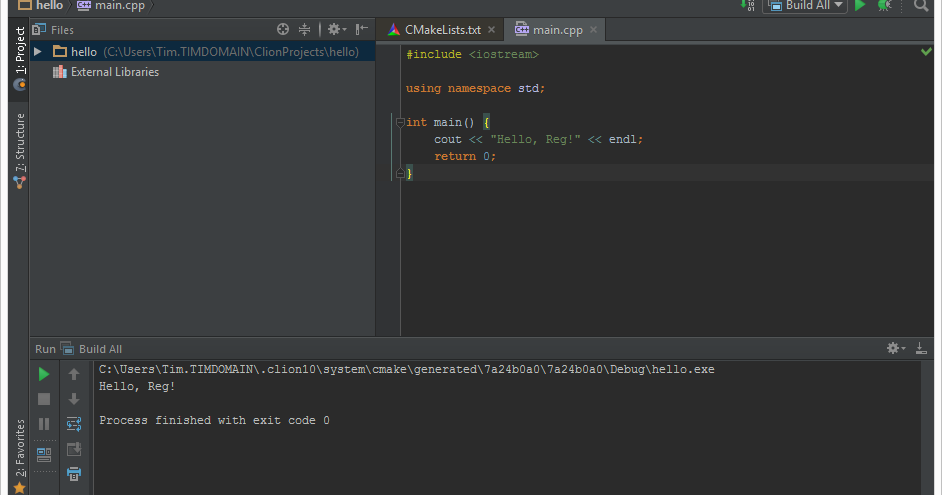With full remote mode, you can work on a macOS, Linux, or Windows desktop targeting a remote Linux machine connected via SSH. You can choose any Linux-based target, including embedded systems on single-board computers like Raspberry Pi. Also, your program can be launched on a cloud platform or, for example, inside a Docker container.
For remote development, the CLion instance runs locally, and your source files are also placed on the local client, with automatic synchronization to the remote host. On the remote host side, CLion performs compilation and build using host compilers and CMake, uses host GDB for debug, and runs the application on the remote target.

Name resolution 2.0 implementaion. Please see meta issue for details. The new name resolution is disabled by default. Please, note that the new resolve engine is in an experimental state and has known regressions. It is intended for internal use. If you wish to give a try: Ensure you have at lease -Xmx1500m in Help Edit custom VM Options Enable org.rust.resolve.new.engine registry key Enable. REM Delete registry key and jetbrains folder (not sure if needet but however) rmdir /s /q '%APPDATA% JetBrains ' reg delete ' HKEYCURRENTUSER Software JavaSoft ' /f. Services view is absent after setting 'kubernetes.view' registry key to true: Usability: IDEA-219486: Services View: make the ability to run configurations in Services discoverable: Cosmetics: IDEA-226054 Services view tabs and toolbar buttons are not aligned: Version Control. Git: Bug: IDEA-176615: Endless loop of 'git rebase' on. Restart CLion and check 'Settings' - 'Build, Execution, Deployment' to make sure CLion has picked up the right versions of Cygwin, make and gdb Check the project configuration ('Run' - 'Edit configuration') to make sure your project name appears there and you can select options in 'Target', 'Configuration' and 'Executable' fields. Registry keys are the base unit of organization in the registry, and can be compared to folders in File Explorer. A particular key can have subkeys, just as a folder can have subfolders. Each key can be deleted, as long as the user has the appropriate permissions to do so, and the key is not a base key or at the level directly under the base keys.
When working on a Windows client, keep in mind the following:
Due to the IntelliJ platform issue, you need to set the property value
idea.case.sensitive.fs=truein the idea.properties file (to access the property file, select Help | Edit Custom Properties... on the main menu), then restart CLion with cache reset (File | Invalidate Caches / Restart...).For files synchronization on Windows, CLion relies on its own Remote Host Access and compression on the host side using the tar utility. This mechanism causes the synchronization to perform slower than rsync on macOS and Linux.
Create a toolchain with remote credentials
Go to Settings / Preferences | Build, Execution, Deployment | Toolchains and select Remote Host from the list of toolchains or click and select Remote Host from the drop-down menu to create a new toolchain.
Click next to the Credentials field. In the dialog that opens, create an SSH configuration and provide the credentials for accessing you remote machine. Existing SSH configurations are available from the drop-down list.
You can also manage SSH configurations in Settings / Preferences | Tools | SSH Configurations.
After establishing the connection, CLion attempts to detect the tools in default remote locations /usr/bin/cmake and /usr/bin/gdb (or using the full paths, if you have provided manually). When the checks finish successfully, the toolchain is ready for use:
You can make the newly created toolchain the default one (for this, move it to the top of the toolchains list by clicking ). When set as default, the remote toolchain is used for all the projects you create and open in CLion.
Note that if you set the remote toolchain as default, the default CMake profile will connect to it automatically, so you do not need to configure a separate CMake profile for it.

Create the corresponding CMake profile
Skip this procedure if your remote toolchain is set as default.
Go to Settings / Preferences | Build, Execution, Deployment | CMake, click to create a new CMake profile, and connect it to your remote toolchain using the Toolchain field:
Check and adjust the deployment configuration
When you create a connection entity for the remote toolchain, CLion puts it in the list of server access configurations in Settings / Preferences | Build, Execution, Deployment | Deployment.
CLion automatically configures the paths for your project code synchronization. Use the Mappings tab to change the default mappings (for example, to set a particular remote directory for the copied sources instead of the default tmp folder):
You can monitor the synchronization process in the File Transfer tool window (View | Tool Windows | File Transfer):

Excluded paths
By default, CLion indexes and synchronizes all the directories listed in CMakeLists.txt. However, if you exclude a directory using the Mark Directory as | Excluded action, it will be marked as Excluded path for the remote deployment and will not be synchronized with the remote machine. This is performed automatically when you exclude a folder before configuring a remote toolchain.
You can check and adjust the excluded paths in the dedicated tab of the deployment entry settings:
If you mark a directory as excluded when there is a remote toolchain configured and the project has been synchronized already, CLion will suggest that you update the excluded paths. After the update, the excluded folder will be synchronized further.
If you un-exclude a previously excluded directory, CLion will suggest to update the list of the excluded paths and re-upload the folder to the remote host.
Clion License Key
Resync header search paths
To resolve your code correctly, CLion synchronizes header search paths with all the content from the remote machine to the local client. For example, even though standard library headers are taken from the target, you can navigate to them as if you were working locally in the CLion editor.
However, header search paths synchronization can be time-consuming, so CLion performs it automatically only upon the initial file transfer. After that, it is not triggered by CMake reloads. So every time you switch the compiler or make changes in your project dependencies, make sure to update header search paths manually by calling Tools | Resync with Remote Hosts.
Note that you need to call Resync with Remote Hosts manually for every change in your project dependencies or compilers.
You can also switch to automatic synchronization: set the clion.remote.resync.system.cache key in the Registry (go to Help | Find Action or press Ctrl+Shift+A , type Registry, and search for the key by name).
Build, run, debug
Clion Download Student
Now that you have a remote toolchain and the corresponding CMake profile configured, you can build, run, and debug your application and tests in the completely remote way by selecting the proper CMake profile in the Run/Debug configuration switcher:
Also, you can use the remote SSH terminal and run remote external tools as a Before launch step of your Run/Debug configuration.
Below you can find a demo showing how the application output changes depending on the OS that it runs on. Having macOS as a local system, we connect remotely to the Ubuntu target and check the OS name. In this example, code highlighting depends on the OS identifier, so when we switch the CMake profile or resolve context, CLion highlights the corresponding code branch:
Clion Shortcut
Enable IPv6 support
Clion Crack
To connect to IPv6 networks, you need to make adjustments in CLion JVM options:
Run Help | Edit Custom VM Options from the main menu. In the *.vmoptions file that opens, delete the
-Djava.net.preferIPv4Stack=trueline and add the following lines:-Djava.net.preferIPv4Stack=false -Djava.net.preferIPv6Stack=true -Djava.net.preferIPv6Addresses=trueRestart CLion.
In order to use hostnames instead of raw addresses, open C:WindowsSystem32Driversetchosts as Administrator on Windows or /etc/hosts as superuser on macOS/Linux and map the required addresses to the corresponding hostnames.
Each address should be placed on a separate line, followed by at least one whitespace and a list of whitespace-separated hostnames, for example:
f381::171d:c61c:c7f3:3a56 my.dev.host1 my.dev.host2 f381::171d:c61c:c7f3:3a26%en0 my.dev.host3On macOS, you also need to specify the list of the banned network interfaces:
Go to Help | Find Action and type Registry.
Find the deployment.macOs.bannedInterfaces key and set a comma-separated list of the interfaces to be banned, for example
awdl0,bridge0,en1,en2,lo0,p2p0,utun0,utun1.